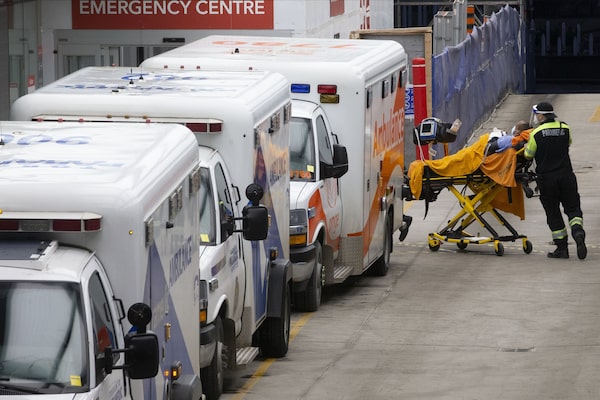
Paramedics wheel a patient past ambulances outside a Toronto hospital in early January, 2022. Theresa Tam, Canada's Chief Public Health Officer, told a virtual press conference Friday, Jan. 14 that the peak of the Omicron wave may be in sight, though modelling suggests hospitalizations will still rise.Chris Young/The Canadian Press
Canada could be approaching the peak of the Omicron wave of COVID-19 as case counts stabilize in the most populous provinces, Chief Public Health Officer Theresa Tam said on Friday, but she warned hospitalizations will still grow.
Dr. Tam told a virtual news conference the peak of the wave was in sight, but there is still significant uncertainty about when cases and hospitalizations will start to decline.
“I think a number of provinces, the biggest ones, who have particularly experienced the surge the earliest, are seeing some stabilization, at a very high level, but some stabilization in the daily case rates,” Dr. Tam said.
“I think this is the early signal that we could be approaching that peak.”
In B.C. on Friday, health officials gave a similar message, and said the wave in cases appears to have crested, but the same can’t yet be said for hospitals.
Dr. Tam made the comments as the Public Health Agency of Canada released its latest modelling of the COVID-19 disease trajectory. The modelling underscores the massive increase in overall case counts, but confirms that Omicron is likely less severe than past variants of the virus. Despite that, the sheer number of cases is driving hospitalizations, putting pressure on the health care system, and will make even the downside of the Omicron wave difficult.
Where do I book a COVID-19 booster or a vaccine appointment for my kids? Latest rules by province
Several weeks of “very intense” disease activity are still to come, the agency warned in the modelling.
Because testing capacity has buckled under the volume of cases, the Public Health Agency had to estimate the number. The modelling shows that with the current public-health measures, daily case counts could peak at between 100,000 and 250,000 a day across the country.
The modelling shows that in total, Canada has likely hit or will soon hit the peak in case numbers, and hospital admissions will peak shortly afterward. But Dr. Tam said the models are uncertain, and the public-health agency will have a better understanding of the wave’s trajectory in a week.
“There’s a grey zone or a zone of uncertainty” in the projections and the actual case trends, Dr. Tam said. “It is quite possible that in the next days we’ll see that peak, at least in the cases.”
Dr. Tam said the case trajectory could be in line with the experience in other countries: “a sharp, sharp increase and then it coming down fairly fast.”
“But I think we’re all just wanting to be a bit cautious about pronouncing on that until we’ve seen more information,” she said.
The modelling released by the federal agency also shows that the national test positivity rate has peaked, but at a very high number. Currently, 28 per cent of lab tests – more than one in four – are coming back positive for the virus.
On Thursday, Ontario and Quebec said they may be nearing peak hospital admissions in the Omicron-driven wave of the pandemic, bringing some hope of relief to the health care system and a chance to begin easing restrictions as early as next week.
B.C. Provincial Health Officer Bonnie Henry said on Friday that community transmission appears to have peaked, but the next two weeks will be challenging for hospitals.
“At least in terms of transmission in the community, we’ve reached the peak and we’re starting on that downward trajectory,” Dr. Henry told a news conference. According to the latest modelling, B.C.’s public-health office calculates that hospital admissions will likely reach the highest point by Jan. 21, and it will be another week before the number of patients in hospital declines.
The model is based on limited data because British Columbia’s testing capacity hit its limit in December, and people who are not considered high risk are being asked simply to isolate if they have COVID-19 symptoms. Dr. Henry said she has confidence in the projections, however, because surveillance of wastewater – which tests for concentrations of the virus – has confirmed the same pattern of decline.
While the wave fuelled by the Omicron variant has led to a record-breaking number of COVID-19 cases in B.C., patients typically have shorter hospital stays than those infected with the Delta variant, she noted. But the challenges in B.C hospitals are still acute because more health care workers are off sick.
“The next few weeks are going to be the most challenging yet on our health care system,” she said. The provincial government cancelled non-urgent surgeries starting last week to ease the pressure on hospitals, and is scouting locations for a field hospital in downtown Vancouver in case the number of beds falls short of demand.
For subscribers: Get exclusive political news and analysis by signing up for the Politics Briefing.
 Marieke Walsh
Marieke Walsh Justine Hunter
Justine Hunter